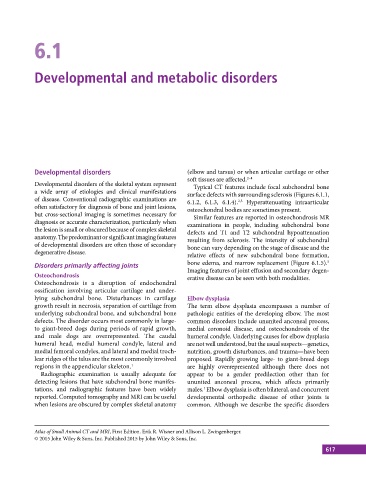Page 627 - Atlas of Small Animal CT and MRI
P. 627
6.1
Developmental and metabolic disorders
Developmental disorders (elbow and tarsus) or when articular cartilage or other
soft tissues are affected. 2–4
Developmental disorders of the skeletal system represent Typical CT features include focal subchondral bone
a wide array of etiologies and clinical manifestations surface defects with surrounding sclerosis (Figures 6.1.1,
of disease. Conventional radiographic examinations are 6.1.2, 6.1.3, 6.1.4). Hyperattenuating intraarticular
2,3
often satisfactory for diagnosis of bone and joint lesions, osteochondral bodies are sometimes present.
but cross‐sectional imaging is sometimes necessary for Similar features are reported in osteochondrosis MR
diagnosis or accurate characterization, particularly when examinations in people, including subchondral bone
the lesion is small or obscured because of complex skeletal defects and T1 and T2 subchondral hypoattenuation
anatomy. The predominant or significant imaging features resulting from sclerosis. The intensity of subchondral
of developmental disorders are often those of secondary bone can vary depending on the stage of disease and the
degenerative disease. relative effects of new subchondral bone formation,
5
Disorders primarily affecting joints bone edema, and marrow replacement (Figure 6.1.5).
Imaging features of joint effusion and secondary degen
Osteochondrosis erative disease can be seen with both modalities.
Osteochondrosis is a disruption of endochondral
ossification involving articular cartilage and under
lying subchondral bone. Disturbances in cartilage Elbow dysplasia
growth result in necrosis, separation of cartilage from The term elbow dysplasia encompasses a number of
underlying subchondral bone, and subchondral bone pathologic entities of the developing elbow. The most
defects. The disorder occurs most commonly in large‐ common disorders include ununited anconeal process,
to giant‐breed dogs during periods of rapid growth, medial coronoid disease, and osteochondrosis of the
and male dogs are overrepresented. The caudal humeral condyle. Underlying causes for elbow dysplasia
humeral head, medial humeral condyle, lateral and are not well understood, but the usual suspects—genetics,
medial femoral condyles, and lateral and medial troch nutrition, growth disturbances, and trauma—have been
lear ridges of the talus are the most commonly involved proposed. Rapidly growing large‐ to giant‐breed dogs
regions in the appendicular skeleton. 1 are highly overrepresented although there does not
Radiographic examination is usually adequate for appear to be a gender predilection other than for
detecting lesions that have subchondral bone manifes ununited anconeal process, which affects primarily
tations, and radiographic features have been widely males. Elbow dysplasia is often bilateral, and concurrent
1
reported. Computed tomography and MRI can be useful developmental orthopedic disease of other joints is
when lesions are obscured by complex skeletal anatomy common. Although we describe the specific disorders
Atlas of Small Animal CT and MRI, First Edition. Erik R. Wisner and Allison L. Zwingenberger.
© 2015 John Wiley & Sons, Inc. Published 2015 by John Wiley & Sons, Inc.
617

